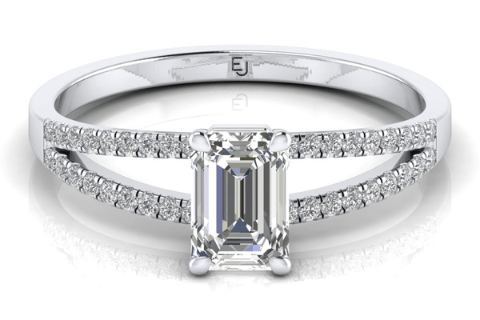Since the discovery of the first diamond in the 4th century BC, they’ve maintained a reputation for luxury and charm. Lusted after by the richest and most famous throughout history and a staple in the love lives of soon-to-be-wed couples today, the diamond was and will remain in high demand.
Today, the high demand for diamonds, a more conscious customer approach and technological evolutions created a whole new way to form a diamond that requires no mining, no conflict and zero exploitation of land or people – the lab-grown diamond. Lab grown diamonds are also known as lab created diamonds, man made diamonds or cultured diamonds, are grown in the controlled environment of a laboratory using advanced technology, replicating the conditions under which the traditional diamonds are naturally formed.
Here are 10 Interesting Facts About Lab Grown Diamonds, that you probably didn’t know!
1. Lab-Grown Diamonds Go by Multiple Names
When on the hunt for lab-grown diamonds, you may run into a number of names, including:
- Lab-made diamonds
- Cultured diamonds
- Man-made diamonds
- Lab-created diamonds
- Engineered diamonds
- Chemical vapor deposition (CVD) diamonds
2. Lab-Grown Diamonds Are 100% Real Diamonds
It’s not certain where this rumor started but – some think that lab-grown diamonds are the same as synthetic diamonds. Synthetic or artificial products are created to imitate or simulate a product (the most popular diamonds simulants are Moissanite or Cubic Zirconia). Lab-grown diamonds are not imitations, they are 100% real. Chemically and physically comparing lab-grown vs. mined diamonds, you’ll find that they are exactly the same – the only difference is one is grown in a lab while the other is formed underground. Since 2019, the GIA has also abandon the word synthetic and rebrand created diamonds as Laboratory-Grown Diamond in their reports.
3. The Creation of Lab-Grown Diamonds Involves Complex Chemistry
To make a diamond in the lab, two processes can be used: chemical vapor deposition (CVD) and high-pressure torsion (HPT).
Chemical Vapor Deposition (CVD)
CVD produces diamonds from a thin slice of diamond seed. It’s locked into a chamber that’s heated up to 800 degrees Celsius and then filled with carbon-rich gas. These gasses, along with lasers, break bonds so that carbon can attach. Once the carbon bonds are in place, growth will begin, forming a diamond from the smallest atomic particle and beyond.
High-Pressure Torsion (HPT)
Another process used in the formation of diamonds in the lab is HPT. Using two hydraulic plungers, a large amount of pressure is placed on materials to condense fine particles into an ultra-fine, pure form of a diamond.
Both of these work to produce the purest form of materials, which is why you get a high-quality diamond with each lab-growing process.
4. Lab-Grown Diamonds Have The Same Chemical and Physical Properties As Mined Diamonds
The chemical structure of naturally sourced diamonds is crystallized carbon. Lab-grown diamonds have the exact same chemical composition. Because they are chemically the same, they’re also physically the same, giving off the same glistening, rocky formation.
5. All Lab-Grown Diamonds Are Type IIa
Diamonds are categorized into different types based on their impurities. The most commonly found diamond is type Ia (about 95% of all natural diamonds), which contain clusters of nitrogen, classifying them as impure. All lab-grown diamonds are made without impurities, putting them in the category type IIa – the rarest of them all that you can find in nature.
6. Lab-Grown Diamonds Require Fewer Resources
Mining diamonds is rough on the environment. Trees have been cut down, rivers have been rerouted or cut off, and laborers have been exploited. Down in the mines, workers have it rough, breathing in dirt and debris and in constant danger of sudden collapse. Once diamonds are discovered, a hefty amount of water is needed to mine just one carat of diamond, (more than 120 gallons) – 85% more than is needed for lab-grown diamonds.
7. Lab-Grown Diamonds Cost Less
The lack of hard labor, harsh use of resources, and shorter supply chain to mine diamonds results in a significant price drop (25-30% less). Lab-grown diamonds have the same luxurious look and feel without the large cost that comes along with them.
8. Lab-Grown Diamonds Are Conflict-Free, Cruelty-Free, and Ethically Sourced
Lab-grown diamonds don’t come with a reputation of exploitation like mined diamonds do. They’re typically grown in laboratories where employees have good working conditions and pay. There’s no risk of conflict, ethical issues, or any kind of cruelty when producing lab-grown diamonds.
9. Lab-Grown Diamonds Are Less Harmful To The Environment Than Mined Diamonds
Digging deep into the ground to mine diamonds can pollute the air, contaminate water, and disturb the soil, leading to less-than-stable living conditions for surrounding communities. Lab-grown diamonds do none of the above, grown peacefully in a lab with safe, eco-friendly methods.
10. Lab-Grown Diamonds Are Graded the Same as Mined Diamonds
When mined diamonds are graded, professionals like the Gemological Institute of America (GIA) look for the 4 Cs: clarity, color, cut, and carat. Labs that grade and certify diamonds use the same process for both mined diamonds and lab-grown diamonds – unable to distinguish between the two unless specified beforehand. Learn more about lab grown diamonds certifications Here.


